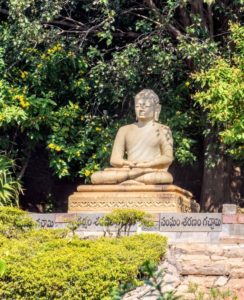
When prince Siddhartha attained illumination, the Gods spoke to him saying “Now, go back and show others the path to illumination”. Siddhartha exclaimed “but this cannot be taught!” “We know” the Gods replied. “Now go back and teach it anyway”
In 1992 I was hired to teach meditation to Faculty at the University of Texas at Austin. The third week of the semester I shared a meditation that involves counting breaths, starting at ten and counting back to one. ‘If your mind wanders start over. If you get all the way to one start over.’ This meditation is designed to teach students to notice when their mind wanders and come back to the meditation. Over time it can improve concentration.
After the meditation ended I checked in with students. One middle aged woman complained about how difficult the meditation was. I asked her to elaborate. “Well, the first time I counted back from 10 until I got to 6 and then I realized that I was thinking about what groceries to pick up on the way home, so I started back at 10. The second time I got to 4. Then I saw a white light. It was the most beautiful light I have ever seen. It was so peaceful and loving. I felt myself flowing towards this light, dissolving into bliss…. Then I remembered the instructions so I came back to the meditation, but it was very difficult!”.
This was the first time I truly understood what J. Krishnamurti meant when he said “Meditation… one cannot possibly learn it from anybody.” Anything that can be taught is not meditation, it is technique. As long as we cling to technique we will never experience the meditation that Krishnamurti spoke of.

However, that does not mean that the myriad of techniques hold no value. On the contrary, it is while practicing a meditation technique that occasionally, if we are lucky, we slip into a meditative state. Krishnamurti described practicing the techniques of meditation as walking a well-worn path, but meditation itself as walking across a field of freshly fallen snow. The trick is knowing when to hold onto the technique and when it is time to leave all paths behind and experience that which cannot be taught.
This applies not just to mediation, but to asana practice as well. The deeper I venture into my personal practice, the more I understand the story of Siddhartha. Not because I have found enlightenment myself, but because the subtler the terrain I explore, the more deeply I see that what I am experiencing in myself cannot be described, yet alone taught. Ultimately, it may not even exist in others as it exists in me, any more than any two snowflakes are identical.
 I remind myself that my personal practice is personal, not a laboratory for creating new lesson plans for my students. When it comes to the subtlest experience of asana, I know that my students are and always will be, on their own, just as I am on my own, and in that common experience of aloneness we are all one.
I remind myself that my personal practice is personal, not a laboratory for creating new lesson plans for my students. When it comes to the subtlest experience of asana, I know that my students are and always will be, on their own, just as I am on my own, and in that common experience of aloneness we are all one.
2 Comments
-
I appreciated seeing this article in blog form. I finally got myself to do a daily 30′ of asana practice over 4 years ago. I added 30′ of meditation but quit after a year. Too much worrying, falling asleep and just seeing little to no improvement. Someday maybe ill return to it.
-
Charles,
You’re the best.
“…dissolving into bliss…. Then I remembered the instructions…”jb






